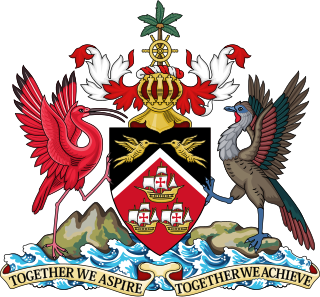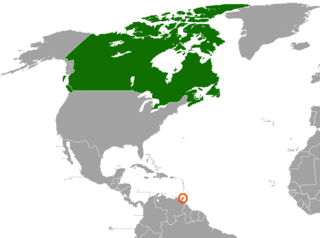
This article is about the demography of the population of Trinidad and Tobago including population density, ethnicity, education level, health of the populace, economic status, religious affiliations and other aspects of the population.

Trinidad is the larger and more populous of the two major islands of Trinidad and Tobago. The island lies 11 km (6.8 mi) off the northeastern coast of Venezuela and sits on the continental shelf of South America. It is the southernmost island in the West Indies. With an area of 4,768 km2 (1,841 sq mi), it is also the fifth largest in the West Indies.
Indo-Caribbean people or Indian-Caribbean people are people in the Caribbean who trace their ancestry to the Indian subcontinent. They are descendants of the Jahaji indentured laborers from British India, who were brought by the British, Dutch, and French during the colonial era from the mid-19th century to the early 20th century. A minority of them are descendants from people who immigrated as entrepreneurs, businesspeople, merchants, engineers, doctors, religious leaders, students, and other professional occupations beginning in the mid-20th century and continuing to the present.

Indo–Trinidadians and Tobagonians or Indian-Trinidadians and Tobagonians are people of Indian origin who are nationals of Trinidad and Tobago, whose ancestors came from India and the wider subcontinent beginning in 1845 during the period of colonization.
Afro-Trinidadians and Tobagonians are people from Trinidad and Tobago who are of Sub-Saharan African descent, mostly from West Africa. Social interpretations of race in Trinidad and Tobago are often used to dictate who is of West African descent. Mulatto-Creole, Dougla, Blasian, Zambo, Maroon, Pardo, Quadroon, Octoroon or Hexadecaroon (Quintroon) were all racial terms used to measure the amount of West African ancestry someone possessed in Trinidad and Tobago and throughout North American, Latin American and Caribbean history.
Dougla people are Caribbean people who are of mixed African and South Asian descent. The word Dougla is used throughout the Dutch and English-speaking Caribbean. Afro-Indo people may also be another term used to describe them.

The Democratic Labour Party was the main opposition party in Trinidad and Tobago from 1957 till 1976. That party was the party which opposed the People's National Movement (PNM) at the time of Independence. After several splits brought about by leadership struggles, the party lost its hold on the Indo-Trinidadian community in the 1976 General Elections and was displaced in parliament by the United Labour Front under the leadership of Basdeo Panday, a former DLP senator. The party was the representative of the ethnic Indian community in the country; however Indian Muslims and Christians were said to be less loyal to the party than Indian Hindus.
Trinidadian English Creole is an English-based creole language commonly spoken throughout the island of Trinidad in Trinidad and Tobago. It is distinct from Tobagonian Creole – particularly at the basilectal level – and from other Lesser Antillean English creoles.

Hinduism in Trinidad and Tobago is the second largest religion. Hindu culture arrived to Trinidad and Tobago in 1845, with the arrival of the first Indian indentured laborers, the overwhelming majority of which were Hindu. According to the 2011 census there were 240,100 declared Hindus in Trinidad and Tobago.

Trinidad and Tobago, officially the Republic of Trinidad and Tobago, is the southernmost island country in the Caribbean. Consisting of the main islands Trinidad and Tobago and numerous much smaller islands, it is situated 11 kilometres off the coast of northeastern Venezuela and 130 kilometres south of Grenada. It shares maritime boundaries with Barbados to the east, Grenada to the northwest and Venezuela to the south and west. Trinidad and Tobago is generally considered to be part of the West Indies. The island country's capital is Port of Spain, while its largest and most populous municipality is Chaguanas.

Caribbean Hindustani is an Indo-Aryan language spoken by Indo-Caribbean people and the Indo-Caribbean diaspora. It is a koiné language mainly based on the Bhojpuri and Awadhi dialects. These Hindustani dialects were the most spoken dialects by the Indians who came as immigrants to the Caribbean from Colonial India as indentured laborers. It is closely related to Fiji Hindi and the Bhojpuri-Hindustani spoken in Mauritius and South Africa.

Trinidadian and Tobagonian Americans are people with Trinidadian and Tobagonian ancestry or immigrants who were born in Trinidad and Tobago. Trinidad and Tobago is home to people of many different national, ethnic and religious origins. As a result, people of Trinidadian and Tobagonian descent do not equate their nationality with ethnicity. The largest proportion of Trinidadians lives in the New York metropolitan area, with other large communities located in South Florida, Central Florida, Pennsylvania, Maryland, Texas, Minnesota, Georgia, and Massachusetts. There are more than 223,639 Trinbagonian Americans living in the United States.

The following outline is provided as an overview of and topical guide to Trinidad and Tobago:

Diplomatic relations between the Soviet Union and Trinidad and Tobago were established on June 6, 1974. Russia is represented in Trinidad and Tobago through a non-resident embassy in Georgetown, Guyana.
The Punjabi diaspora consists of the descendants of ethnic Punjabis who emigrated out of the Punjab region in the northern part of the South Asia to the rest of the world. Punjabis are one of the largest ethnic groups in both the Pakistani and Indian diasporas. The Punjabi diaspora numbers around the world has been given between 3 and 5 million, mainly concentrated in Britain, Canada, the United States, Western Europe, Southeast Asia, the Middle East, Australia and New Zealand.

Trinidad and Tobago–United Kingdom relations are foreign relations between Trinidad and Tobago and the United Kingdom. Both countries are full members of the Commonwealth of Nations.
White Trinidadians and Tobagonians are Trinidadians of European descent. However, while the term "White Trinidadian" is used to refer collectively to all Caucasians who are Trinidadian, whether by birth or naturalization, the term "local-white" is used to refer more specifically to Trinidad-born Caucasians and, in particular, those who trace their roots back to Trinidad's early settlers.

Trinidadians and Tobagonians, colloquially known as Trinis or Trinbagonians, are the people who are identified with the country of Trinidad and Tobago. The country is home to people of many different national, ethnic and religious origins. As a result, Trinidadians do not equate their nationality with race and ethnicity, but with citizenship, identification with the islands as whole, or either Trinidad or Tobago specifically. Although citizens make up the majority of Trinidadians, there is a substantial number of Trinidadian expatriates, dual citizens and descendants living worldwide, chiefly elsewhere in the Anglosphere.

Gema Ramkeesoon was a Trinidadian and Tobagonian social worker and women's rights activist who was one of the early pioneers of the women's movement in Trinidad and Tobago. She was honored for her social service work as a member of the Order of the British Empire in 1950 and received the gold Hummingbird Medal from Trinidad and Tobago in 1976.

Canada and Trinidad and Tobago established full diplomatic relations in August 1962 after Trinidad's Independence. Since establishing relations, Trinidad and Tobago Defense Force have trained alongside Canadian Forces. As of 2023, there were an estimated 115,225 Trinidadian and Tobagonian Canadians and 4,000 Canadians living in Trinidad and Tobago, 92% of which hold dual citizenship.













